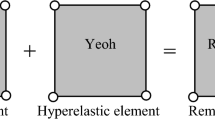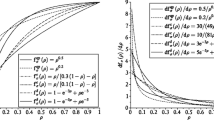Abstract
Continuum topology optimization usually produces results similar to a skeleton structure. In addition, material utilization in the optimized structure is greatly improved compared with the original structure. On the other hand, the redundancy of the structure is greatly reduced due to the removed material. Partial local failure in the optimized structure makes it more difficult for the entire structure to meet strength/stiffness requirements. Using the independent continuous mapping (ICM) method, with minimal weight as the objective and both stress and displacement as the respective constraints, continuum topology optimization models which also consider damage can be employed. A dual-sequence quadratic programming (DSQP) algorithm was used in this work to solve such topology optimization models. Numerical examples confirmed the effectiveness and feasibility of the models. The results indicated that both good load path and weight reduction can be obtained. In addition, compared with the structure obtained using conventional topology optimization, redundancy is greatly improved, and the strength/stiffness requirements for the structure can be satisfied for each damage scenario. Furthermore, the results indicate that the strength/stiffness of the structure, after topology optimization, is only slightly sensitive to local damage.
























Similar content being viewed by others
References
Sui, Y.K., Ye, H.L.: Continuum Topology Optimization Methods ICM. Science Press, Beijing (2013). (in Chinese)
Bendsøe, M.P., Kikuchi, N.: Generating optimal topologies in structural design using a homogenization method. Comput. Methods Appl. Mech. Eng. 71, 197–224 (1988)
Mlejnek, H.P.: Some aspects of the genesis of structures. Struct. Optim. 5, 64–69 (1992)
Xie, Y.M., Steven, G.P.: A simple evolutionary procedure for structural optimization. Comput. Struct. 49, 885–896 (1993)
Osher, S., Sethian, J.: Fronts propagating with curvature dependent speed-algorithms based on Hamilton–Jacobi formulations. Comput. Phys. 79, 12–49 (1988)
Bourdin, B., Chambolle, A.: Design-dependent loads in topology optimization. ESAIM Control Optim. Calc. Var. 9, 19–48 (2003)
Sui, Y.K., Peng, X.R.: The improvement for the ICM method of structural topology optimization. Chin. J. Theor. Appl. Mech. 37, 190–198 (2005). (in Chinese)
Guo, X.: Doing topology optimization explicitly and geometrically: a new moving morphable components based framework. J. Appl. Mech. 81, 081009 (2014)
Zhang, W., Chen, J., Zhu, X.: Explicit three dimensional topology optimization via moving morphable void (MMV) approach. Comput. Methods Appl. Mech. Eng. 322, 590–614 (2017)
Dan, M., Curley, J.: Effects of damage and redundancy on structural reliability. J. Struct. Eng. ASCE 113, 1533–1549 (1987)
Arora, J., Haskell, D., Govil, A.: Optimal design of large structures for damage tolerance. AIAA J. 18, 563–570 (1980)
Feng, Y., Moses, F.: Optimum design, redundancy and reliability of structural systems. Comput. Struct. 24, 239–251 (1986)
Marhadi, K., Venkataraman, S., Wong, S.: Load redistribution mechanism in damage tolerant and redundant truss structure. Struct. Multidiscip. Optim. 44, 213–233 (2011)
Marhadi, K., Venkataraman, S.: Surrogate measures to optimize structures for robust and predictable progressive failure. Struct. Multidiscip. Optim. 39, 245–261 (2009)
Jansen, M., Lombaert, G., Schevenels, M., et al.: Topology optimization of fail-safe structures using a simplified local damage model. Struct. Multidiscip. Optim. 49, 657–666 (2014)
Zhou, M., Fleury, R.: Fail-safe topology optimization. Struct. Multidiscip. Optim. 54, 1–19 (2016)
Li, L., Zhang, G., Khandelwal, K.: Failure resistant topology optimization of structures using nonlocal elastoplastic-damage model. Struct. Multidiscip. Optim. 58, 1589–1618 (2018)
Liu, J., Wen, G.: Continuum topology optimization considering uncertainties in load locations based on the cloud model. Eng. Optim. 50, 1041–1060 (2017)
Liu, J., Wen, G., Qing, Q., et al.: Robust topology optimization for continuum structures with random loads. Eng. Comput. 35, 710–732 (2018)
Wang, J., Cheng, G.D.: Optimal topology design of thin plate with stress constraints. Acta Mech. Solida Sin. 18, 317–322 (1997). (in Chinese)
Cheng, G.D., Zhang, D.X.: Topological optimization of plane elastic continuum with stress constraints. J. Dalian Univ. Technol. 35, 1–9 (1995). (in Chinese)
Guan, H., Steven, G., Xie, Y.: Evolutionary structural optimization incorporating tension and compression materials. Adv. Struct. Eng. 2, 273–288 (1999)
Sui, Y.K., Ye, H.L., Peng, X.R., et al.: The ICM method for continuum structural topology optimization with condensation of stress constraints. Chin. J. Theor. Appl. Mech. 39, 554–563 (2007). (in Chinese)
Zhang, W., Li, D., Zhou, J., et al.: A moving morphable void (MMV)-based explicit approach for topology optimization considering stress constraints. Comput. Methods Appl. Mech. Eng. 334, 381–413 (2018)
Yang, D., Liu, H., Zhang, W., et al.: Stress-constrained topology optimization based on maximum stress measures. Comput. Struct. 198, 23–39 (2018)
Sui, Y.K., Yang, D.Q., Wang, B.: Topological optimization of continuum structure with stress and displacement constraints under multiple loading cases. Chin. J. Theor. Appl. Mech. 32, 179–189 (2000). (in Chinese)
Zhu, R., Sui, Y.K.: Topological optimization of plate and shell-like structures with displacement constraints under multi-state loadings based on ICM method. Chin. J. Solid Mech. 33, 81–90 (2012). (in Chinese)
Rong, J.H., Xing, X.J., Deng, G.: A structural topological optimization method with variable displacement constraint limits. Chin. J. Theor. Appl. Mech. 41, 431–439 (2009). (in Chinese)
Acknowledgements
The work was supported by the National Natural Science Foundation of China (Grant 11072009).
Author information
Authors and Affiliations
Corresponding author
Rights and permissions
About this article
Cite this article
Du, J., Guo, Y., Chen, Z. et al. Topology optimization of continuum structures considering damage based on independent continuous mapping method. Acta Mech. Sin. 35, 433–444 (2019). https://doi.org/10.1007/s10409-018-0807-7
Received:
Revised:
Accepted:
Published:
Issue Date:
DOI: https://doi.org/10.1007/s10409-018-0807-7




